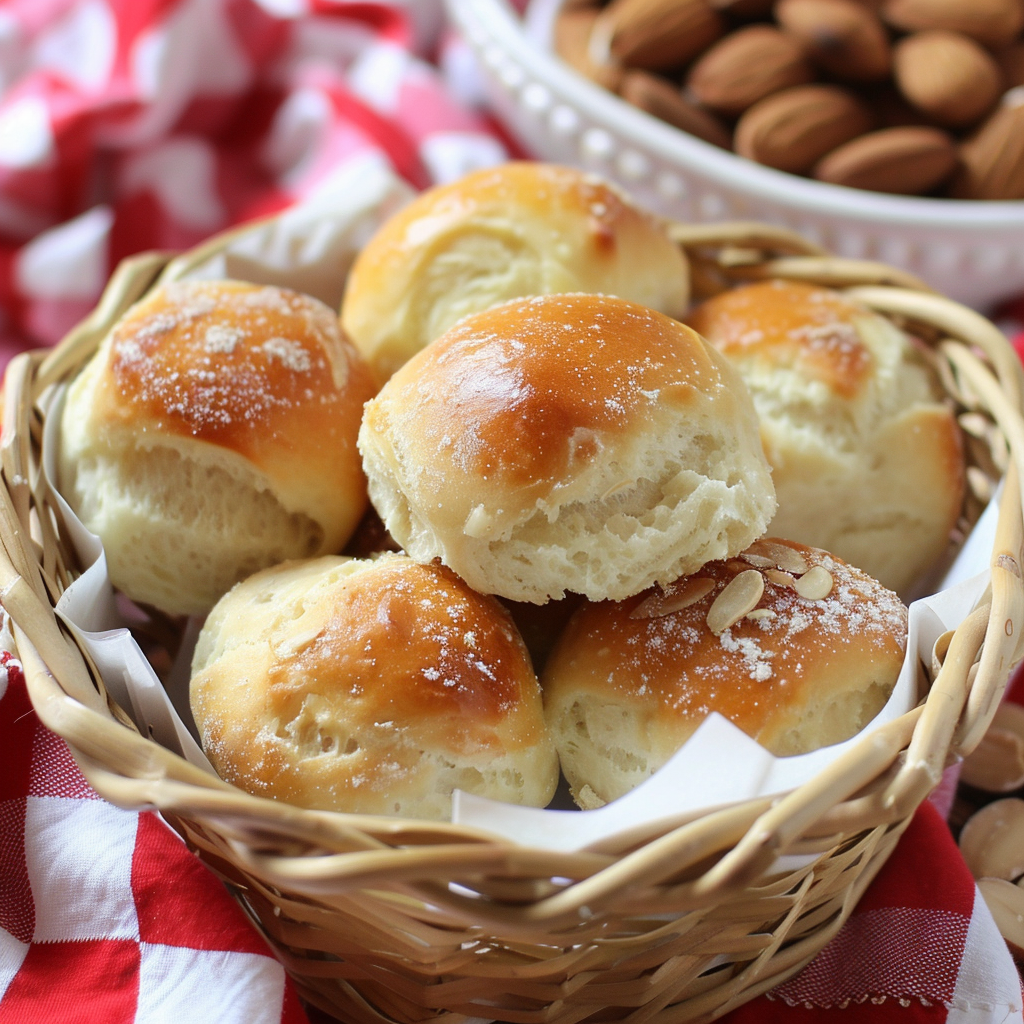Nutritious and Delicious Almond Flour Dinner Rolls Recipe

Share
When I’m looking for dinner rolls that not only taste incredible but also offer a nutritional boost, these Almond Flour Dinner Rolls are fantastic. The combination of almond flour and all-purpose flour gives these rolls the perfect balance of flavor and texture. Almond flour brings a subtle nutty flavor and adds a nutrient-rich twist, while the all-purpose flour ensures that they stay light and fluffy. Whether I’m serving them alongside a hearty stew or as a side dish for a special occasion, these rolls always impress. They’re also easy to make, and with a few key tips, you can achieve bakery-quality rolls right from your kitchen.
Did You Know?
Almond flour is not only gluten-free but also packed with nutrients. It’s high in protein, healthy fats, and vitamin E, which is great for your skin and immune system. Compared to regular flour, almond flour has fewer carbohydrates, making these rolls a great option for those looking to reduce their carb intake while still enjoying a delicious, homemade roll.
Yield: 12 Rolls
Ingredients:
1 1/2 cups almond flour
1 cup all-purpose flour
2 1/4 tsp active dry yeast (1 packet)
1/2 cup warm water (110°F)
2 tbsp honey
1/4 cup unsalted butter, melted
2 large eggs
1 tsp salt
1/2 tsp baking powder
Instructions:
Prepare the Dough:
In a small bowl, combine warm water and yeast. Add the honey and stir. Let the mixture sit for 5 minutes until frothy.
Personal Tip: Always use water around 110°F to activate the yeast properly. If the water is too hot, it can kill the yeast and prevent the dough from rising.
In a large bowl, whisk together almond flour, all-purpose flour, salt, and baking powder. In a separate bowl, whisk the eggs and melted butter. Add the yeast mixture to the wet ingredients and stir until combined. Gradually fold in the dry ingredients until a dough forms.
Knead Dough:
Knead the dough on a floured surface for about 5 minutes until smooth and elastic. This helps develop the gluten, which gives structure to the rolls.
Personal Tip: If the dough is too sticky, sprinkle a little more flour on your hands to help with the kneading process.
Shape and Bake:
Divide the dough into 12 equal pieces. Roll each piece into a ball and place them in a greased 9x13-inch baking dish. Cover the rolls and let them rise in a warm place for 20-30 minutes or until doubled in size.
Personal Tip: I like to place the baking dish in a slightly warm (but turned off) oven to help the dough rise faster.
Preheat the oven to 375°F (190°C) and bake the rolls for 15-18 minutes until golden brown.
Personal Tip: Rotate the pan halfway through baking to ensure the rolls bake evenly.
Serve:
Brush the tops of the warm rolls with melted butter before serving.
Nutritional Information (Per Roll):
Calories, 150; Protein, 4g; Carbohydrates, 15g; Fiber, 2g; Net Carbohydrates, 13g; Fat, 10g; Saturated Fat, 3g; Cholesterol, 40mg; Sodium, 180mg; Sugars, 3g; Glycemic Index, Medium
Kitchen Tips, Great Ideas, How to Save Money
-
Choosing Almond Flour: Use finely ground almond flour for the best texture. While almond meal is an option, it may make the rolls slightly denser.
-
Yeast Activation: Be sure the water is warm (around 110°F) to activate the yeast properly. This ensures your dough rises well, resulting in fluffier rolls.
-
Kneading Dough: Knead the dough long enough for gluten to develop. This will give the rolls structure and help them hold their shape.
-
Make Ahead: You can prepare the dough the night before and let it rise in the refrigerator. This allows you to have fresh rolls ready to bake the next day without much effort.
-
Storing Leftovers: Store leftover rolls in an airtight container for up to 2 days at room temperature, or refrigerate for up to a week. Freeze for longer storage, then thaw and reheat.
-
Serving Suggestions: These rolls are perfect with a pat of butter or a drizzle of honey. They also pair well with soups, stews, or holiday meals.
-
Cost-Saving Tips: Buy almond flour in bulk to save money. Store it in a cool, dry place to keep it fresh. Consider using store-brand ingredients for more savings.
-
Adding Flavor: Add herbs like rosemary or thyme to the dough for a fragrant twist. You can also sprinkle sesame seeds or poppy seeds on top before baking.
-
Baking Evenly: Rotate the baking dish halfway through the bake time to ensure even browning and a golden crust on each roll.
-
Gluten-Free Option: For a fully gluten-free recipe, replace the all-purpose flour with a gluten-free flour blend. Make sure the yeast and other ingredients are certified gluten-free.
Let’s Learn About Almond Flour
Almond flour is made by grinding blanched almonds into a fine powder, and it’s become a popular ingredient in gluten-free and low-carb baking. Unlike regular wheat flour, almond flour is packed with protein, healthy fats, and essential nutrients like vitamin E and magnesium. This flour also has a much lower glycemic index, meaning it won’t spike blood sugar levels the way white flour can. It’s a great alternative for those looking to reduce their carb intake or follow a gluten-free diet. When using almond flour, it’s important to remember that it absorbs moisture differently than other flours, so you might need to adjust the liquid in recipes. High-quality almond flour will be finely ground, giving your baked goods a lighter, more delicate texture. Always store almond flour in a cool, dry place, as its natural oils can cause it to go rancid if exposed to heat or moisture for too long.


